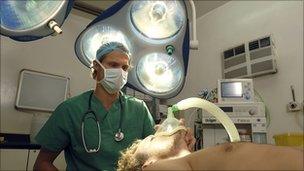NHS Pension Scheme for England and Wales
- Published

The NHS scheme is the second largest public service scheme in the UK
Which employees does the scheme cover?
Staff of all NHS organisations in England and Wales, along with GP practices and direction bodies.
Direction bodies are normally voluntary and non-profit organisations, such as hospices, care in the community and housing associations.
There are similar schemes in Scotland and Northern Ireland.
How many sections are there?
There are two sections of the NHS Pension Scheme called the 1995 section and the newer 2008 section.
How many active, deferred and retired members do they have?
As at 31 March 2010 there were, in England and Wales, 1,368,215 active, 524,726 deferred and 638,610 members in retirement.
In Scotland the scheme has over 153,000 members paying into the scheme, with about 70,000 pensioners.
What are the principal benefits?
Both schemes are final-salary schemes.
In the 1995 section, which closed to new joiners on 1 April 2008, the normal retirement age (NRA) is 60. There is a half final-salary pension after 40 years, based on an annual accrual rate of 1/80th per year, plus an automatic lump sum of 3/80ths.
GPs in the 1995 scheme are in a separate "career average" sub-section with an annual accrual rate of 1.4% of earnings.
In the 2008 section, opened from 1 April 2008, the NRA is 65, but accrual is at a faster rate of 1/60th per year, though there is no automatic lump sum.
GPs are in a separate "career average" sub-section with an annual accrual rate of 1.87% of earnings.
What percentage of salary do employees and employers pay?

The average NHS pension in payment is currently £7,000 a year
Employers pay in 14% of pay while employees pay an amount which is dependant of their whole-time equivalent pay, varying from 5% to 8.5% depending on their earnings.
What are the funding costs of the scheme?
Approximately 20% of salaries.
Is the scheme funded or unfunded?
Unfunded. It is paid for out of general taxation, not an underlying investment fund.
What is the value of the scheme's assets (if any) and its liabilities?
There are no assets.
The scheme liability, which is estimated by the Government Actuary's Department (GAD), is £287.6bn as of 31 March 2010.
"The £287.6bn figure represents all future payments due over the next eight decades or so to cover the accrued rights of around two and a quarter million individuals who work, have worked, or are dependents of individuals who worked in the NHS," said NHS Pensions.
What is the average pension in payment?
The average pension for all members is around £7,000, with average scheme membership of 18 years.
Have there been any changes or reforms to the scheme in recent years?
The most recent change was the introduction of the New NHS Pension Scheme on 1 April 2008, with amendments to the scheme already in place.

For new staff since 2008 the normal pension age is 65, not 60
Are there any further changes in the pipeline?
There are no planned changes to the scheme. John Hutton is currently reviewing public sector pensions and this may have future implications for the NHS pension scheme.
The government intends to revalue pensions in payment in line with inflation as measured by the consumer prices index (CPI) rather than the retail prices index (RPI).
Source: NHS Pensions